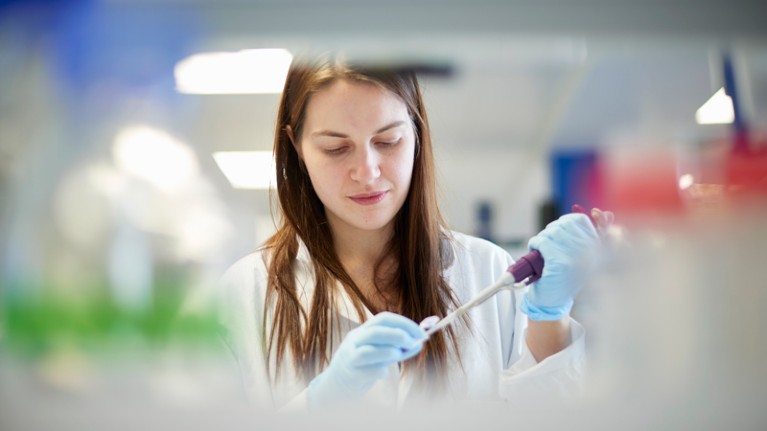
New figures show Nature must do better on using women scientists to write and referee.Credit: Cultura RM Exclusive/Matt Lincoln/Getty
Both in its goals and in its actions, Nature’s editorial team is trying to address the issue of equity in science. See, for example, an Editorial published earlier this month (Nature 558, 5; 2018) and a collection of content from across the Nature group of journals (see go.nature.com/2gjwkkn).
As a part of this effort, we have previously provided statistics and regular updates on the balance between male and female contributors to Nature content, both as authors and as referees. Consistently, these have shown the involvement of too few women when compared with estimates of the number of females present in research communities. (As one indicator, data from the United Nations Educational, Scientific and Cultural Organization show that the global average proportion of women in the science workforce is about 29%; see go.nature.com/2koxupq.)
Since we published our first report on this topic in a 2012 Editorial (Nature 491, 495; 2012), the numbers show we have made some progress, but not enough and too slowly. A key element has been our attempt to counter unconscious bias, by getting senior staff and editors to ask themselves, ‘Who are the outstanding women for this task?’, before commissioning an author or a referee. We cannot claim that this important exercise happens on every occasion, but we have made substantial efforts.
So what do the latest statistics reveal? The sections of Nature that are directly commissioned by in-house editors are where we have most agency, and so have been most responsive to our efforts. In 2017, in our Comment, World View, Books & Arts and Obituary sections, 29% of our 255 authors were women. The proportion of women authors in Comment and World View in 2017 was 34% — an increase since the 19% recorded in 2012.
These articles are commissioned by a team (all female, as it happens) that (like many others) works hard to deliver on this agenda. They report a noticeable tendency for senior women to decline invitations. As was detailed in our 2012 Editorial, there are many reasons why women researchers might have less time for such writing than have men. The team also finds that advisers and invitees, whatever their gender, often send all-male suggestions for alternative authors. We are countering this latter tendency by asking all those who suggest authors or referees to “bear diversity in mind”.
The News & Views section of Nature has considerably improved its position with commissions since we started our initiatives in 2012, when the proportion of women authors stood at 12%. But over the past 3 years, despite keeping up its efforts, that ratio has plateaued at about 26% female — 113 out of 442 authors in 2017.
In the 47 Review articles that we published in 2017, from a total of 217 authors, 42 of them — just over 19% — were women.
Our poorest outcome is in the refereeing of research papers. Counting only individuals whose gender we can attribute from their first names, the proportion of female referees has increased from 12% in 2011 to 16% in 2017.
When assigning gender, we used the algorithm from Gender API. We counted records for which the algorithm could not match the name with a gender, or returned an accuracy below 95%, as ‘unknown gender’. These results are skewed because the algorithm has a hard time identifying gender in some languages, such as Chinese. We counted the referees for all submissions — if a referee reviewed three different manuscripts in a given year, we counted them as three, not as one.
For authors, we counted the total number of corresponding authors in a similar fashion. Counting only authors with an assignable gender, the percentage of female corresponding authors has remained constant at 16% over time.
The editors of Nature and of all the Nature journals have, in recent months, been consolidating existing initiatives on diversity and inclusion, and setting up new ones, to become more systematic and creative about this. We will report on those efforts soon. But the need to work harder is clear for all to see.

 Science benefits from diversity
Science benefits from diversity
 These labs are remarkably diverse — here’s why they’re winning at science
These labs are remarkably diverse — here’s why they’re winning at science
 Making physics more inclusive
Making physics more inclusive




